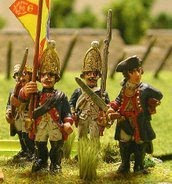
Here are some photos from the
Brother against Brother game I ran at the Carnage convention this past weekend. The scenario was a skirmish level game on a portion of the Gettysburg terrain, specificly the Rose Woods and the Wheatfield, areas where the
5th New Hampshire Volunteers saw action and where their commander, Colonel Cross was mortally wounded. The terrain, and having Colonel Cross and some squads from the 5th New Hampshire are where the historical portion of the scenario ends. Of course you cannot represent the action in this large of a portion of the Gettysburg battlefield in skirmish scale, but the terrain makes for a great backdrop for a scenario game. Thanks goes to my friend Byron for some of the better photos.
This was a close fought game with possession of the wheatfield and the Rose woods, both of the major objectives of the scenario, being split between the Union and Confederate teams. With the objectives split 50/50 the battle came down to casualty counts where the Confederates achieved a minor victory, eliminating one more Union squad than they lost. Everyone had fun and I was very fortunate to have a table of skilled and very sportsmanlike players. Everyone learned the rules by turn 2, and things went smoothly from there on.
Carnage is a mixed convention with historical miniatures, fantasy/science fiction miniatures, board gaming, card gaming and role playing games all at the same convention, each with their own halls or areas. The Carnage staff go to great lengths to provide assistance for the game masters and run a very good convention. I ran this game as part of the "
Centuries of Conflict" themed historical period, which this year was the 19h Century. Next year will be the 20th century, and I have to decide if I'm going to do a Blue Max WWI Air-to-Air combat game or a WWII eastern front battle.
I'm also including a close-up of the Devil's Den terrain piece I made for the game. It's made with gaps between the stones to allow the single-figure skirmish stands to fit between or on top of the rocks as well as on the hill slope. In the Wheatfield photo you can also see the 25mm rail fences I made for the game using my laser cutter. The fences were designed to assemble quickly as I needed to make 14 feet of fences in a couple of hours for the game. I'm considering offering them as my first wargaming product as a new endevor to add to my radio control airplane products. If and when I do I'll post a link here.




 I paint a lot of the figures that I use in my wargames, but I'm also not afraid to buy figures when I can get ones painted as well or better than I can paint myself. The figures shown here are examples of the latter. They're one of the five units of French Young Guard that I'm listing for sale on Ebay (see my auctions here: http://search.ebay.com/_W0QQfgtpZ1QQfrppZ25QQsassZpease1
I paint a lot of the figures that I use in my wargames, but I'm also not afraid to buy figures when I can get ones painted as well or better than I can paint myself. The figures shown here are examples of the latter. They're one of the five units of French Young Guard that I'm listing for sale on Ebay (see my auctions here: http://search.ebay.com/_W0QQfgtpZ1QQfrppZ25QQsassZpease1







































